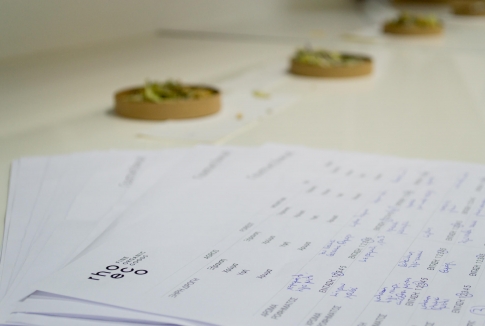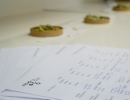rhoeco back to school
Last November, we were more than delighted to receive an invitation from Dr. Maroula Dimopoulou to introduce rhoeco in her class.
Maroula is a Scientific Associate and Lecturer at the Food Science and Technology section of Aristotle’s University School of Agriculture. She has studied Wine and Vine Sciences at Bordeaux University, one of the most renown institutions in the sector of wine studies.
Leader of the Organoleptic Assessment of Foods lab class, she was very kind to think that her students could taste and evaluate our herbal teas as part of their education regarding the organoleptic assessment.
Each of the students received a questionnaire which had to be filled with organoleptic and macroscopic comments about each herbal tea blend.
Students were taken into private booths where they could observe both the dry herbs and the herbal teas and also taste the tisanes. To avoid blending the different flavours, students were advised to eat a slice of crispbread, a well-known method that neutralizes the palate. As part of the assessment, certain steps were followed:
- Observe the colour and texture and smell the dry herbs.
- Before taking a sip from the tisane, close your eyes and take a deep breath. Try to connect the odour with a memory of yours and try to guess its flavour.
- Describe the colour of the tisane. Is it clear or blurry? Is it light-coloured or dark-coloured? How would you describe the colour? [red, yellow, green, white, etc]
- Describe the flavour of the tisane. Take a sip. Try to leave it inside your mouth for a few seconds before swallowing it. Which flavours do you recognise? [bitter, sweet, tart, strong, spicy, etc]. What texture does it leave to your mouth? [subtle, rich, creamy, oily, etc]. Does it feel hydrating?
- Swallow your sip and describe the aftertaste it leaves into your mouth.
Students had to choose a number of a scale from 1 to 5 in order to define how strong was the flavour, the taste and the aftertaste of the herbal tea. They were also expected to write and define with a few key words the colour, the texture, the smell and the level of drying of the dried herbal parts.
Finally, they could optionally name their favourite herbal tea.
We are very happy to share with you the top comments students made for each of our herbal tea blends:
FOREST: wild berry colour, sweet strong flavour, revitalising hydrating aftertaste, natural, earthy, autumn aromas
URBAN: peachy coloured, slightly spicy taste, bittersweet aftertaste, intense, citrus aromas
MOUNTAIN: honey coloured, meadow taste, slightly tart aftertaste, sweet citrus aromas
SEA: golden colour, breezy taste, sweet, mellow aftertaste, like taking-a-walk-into-a-village aromas
AGROS: yellow coloured with green highlights, slightly sweet, honey taste, lemon, sweet aftertaste, uplifting flower aromas
It was really interesting to see that each herbal tea had its followers. Depending on personal taste, any of our herbal teas can become a favourite!
Students found our whole project really interesting and we were excited to give them information about setting up a company.
Most of all, we are glad that we can become inspiration for them and prove that you can make everything with hard work and love for what you do!











